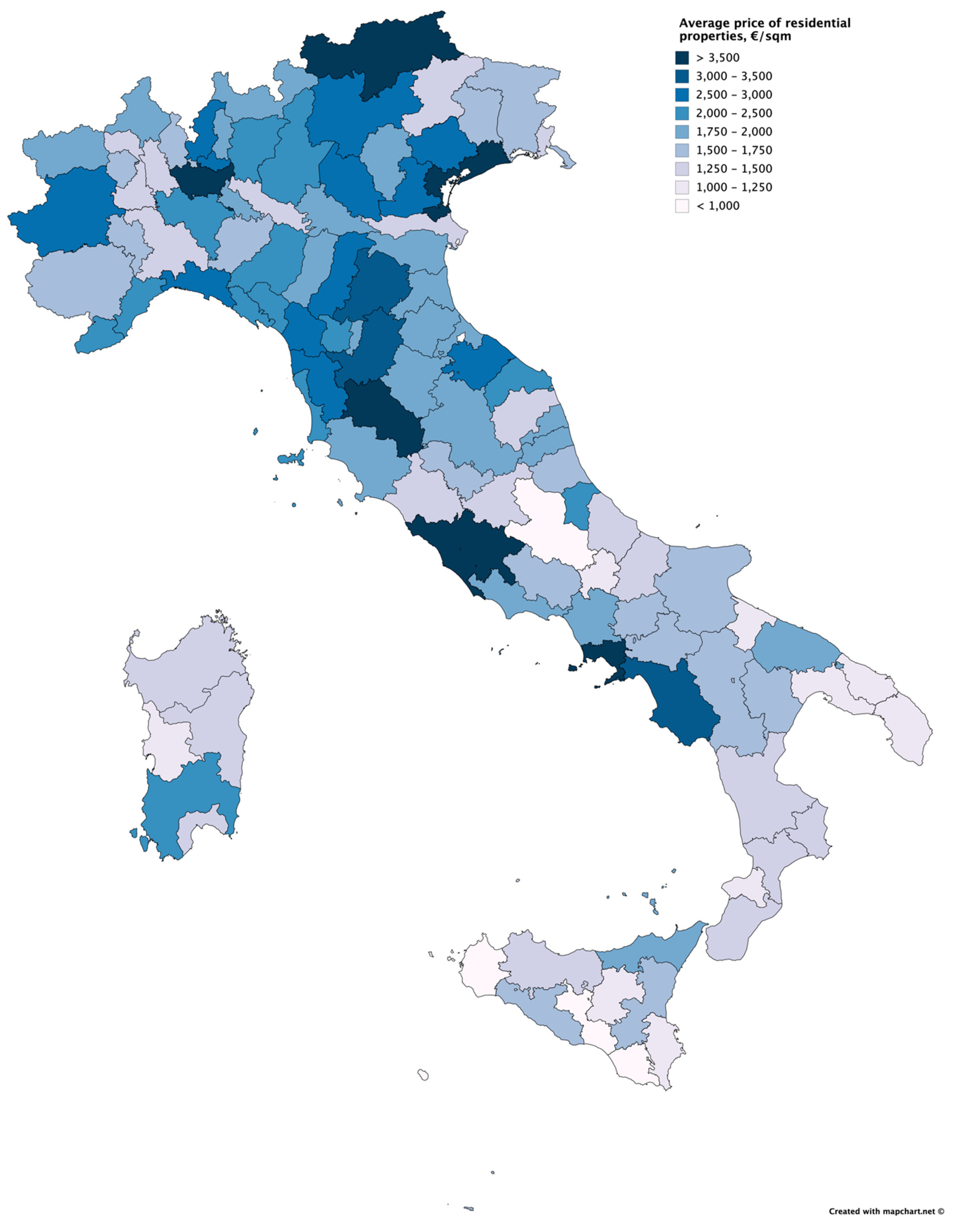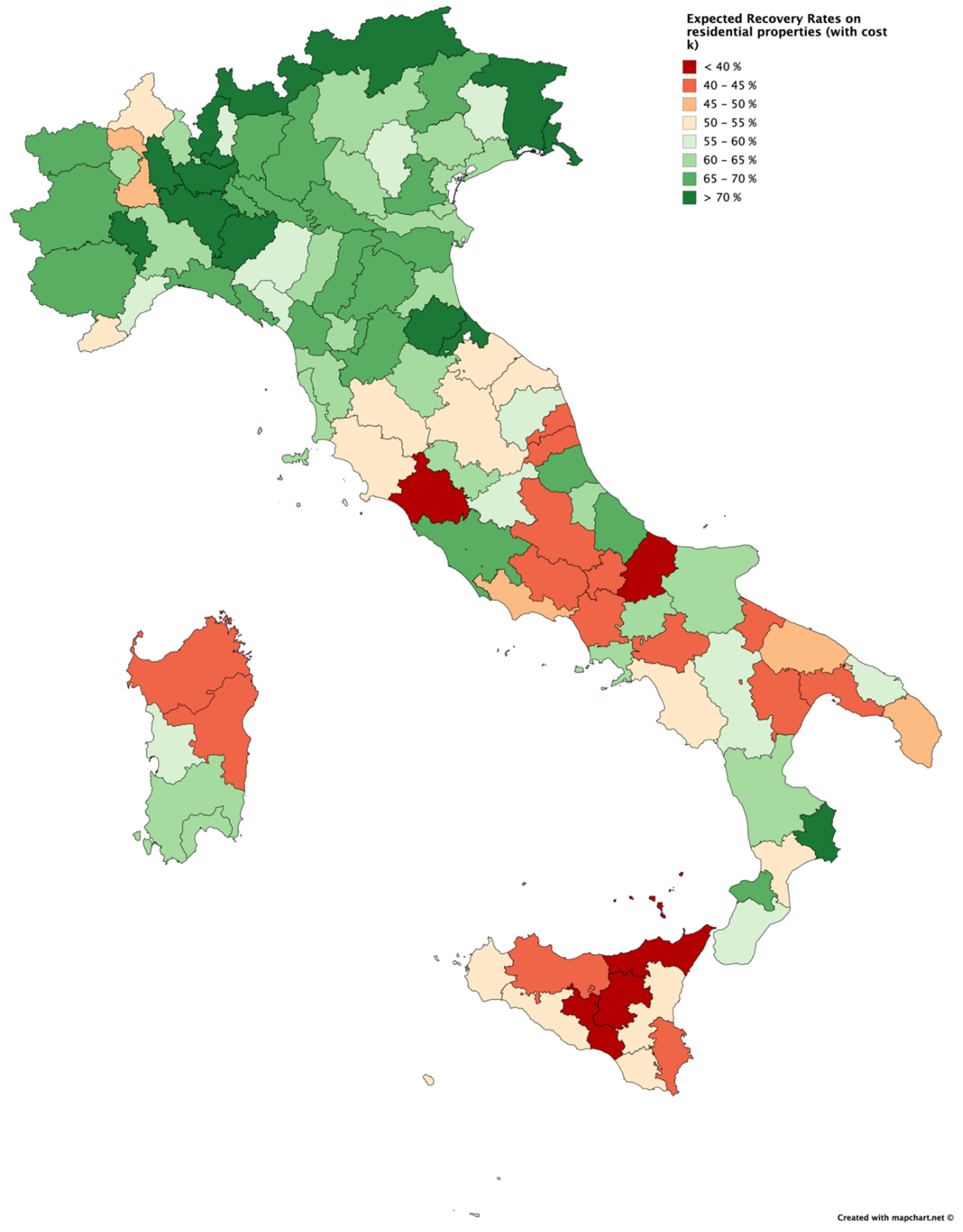Pricing Defaulted Italian Mortgages
Abstract
:1. Introduction
2. Data and Model
2.1. Data
2.2. Model
2.3. Comparison of Price Process Models
3. Results
3.1. Expected Recovery Rates
3.2. Comparison with Moody’s Valuations
4. Conclusions
Author Contributions
Funding
Acknowledgments
Conflicts of Interest
References
- Accornero, Matteo, Piergiorgio Alessandri, Luisa Carpinelli, and Alberto Maria Sorrentino. 2017. Non-Performing Loans and the Supply of Bank Credit: Evidence from Italy. Rome: Bank of Italy, Questioni di Economia e Finanza. [Google Scholar]
- Blanco, Roberto, and Ricardo Gimeno. 2012. Determinants of Default Ratios in the Segment of Loans to Households in Spain. 2012. Banco de Espana Working Paper No. 1210. Available online: https://ssrn.com/abstract=2007059 (accessed on 15 June 2019).
- Chaiyapo, Nattiyaa, and Nattakorn Phewchean. 2017. An application of Ornstein-Uhlenbeck process to commodity pricing in Thailand. Advances in Difference Equations: Springer Open Journal 2017: 179. [Google Scholar] [CrossRef]
- Ciocchetta, Federica, Francesco Maria Conti, Romina De Luca, Igino Guida, Anna Rendina, and Giovanni Santini. 2017. Bad Loan Recovery Rates. Rome: Bank of Italy, Notes on Financial Stability and Supervision, No. 7. [Google Scholar]
- European Banking Authority. 2016. EBA Report on the Dynamics and Drivers of Non-Performing Exposures in the EU Banking Sector. London: European Banking Authority (EBA). [Google Scholar]
- European Systemic Risk Board. 2017a. Annual Report 2017. Frankfurt: European Systemic Risk Board (ESRB), European System of Financial Supervision. [Google Scholar]
- European Systemic Risk Board. 2017b. Resolving Non-Performing Loans in Europe. Frankfurt: European Systemic Risk Board (ESRB), European System of Financial Supervision. [Google Scholar]
- Fabozzi, Frank J., Robert J. Shiller, and Radu S. Tunaru. 2010. Property Derivatives for Managing European Real-Estate Risk. European Financial Management 16: 8–26. [Google Scholar] [CrossRef] [Green Version]
- Fabozzi, Frank J., Robert J. Shiller, and Radu S. Tunaru. 2012. A Pricing Framework for Real Estate Derivatives. European Financial Management 18: 762–89. [Google Scholar] [CrossRef]
- Ferretti, Camilla, Giampaolo Gabbi, Piero Ganugi, Federica Sist, and Pietro Vozzella. 2019. Credit risk migration and economic cycles. Risks 7: 109. [Google Scholar] [CrossRef] [Green Version]
- Fischetto, Antonio Luigi, Igino Guida, Anna Rendina, Giovanni Santini, and Marco Scotto di Carlo. 2018. Bad Loan Recovery Rates in 2017. Rome: Bank of Italy, Notes on Financial Stability and Supervision, No. 13. [Google Scholar]
- Frontczak, Robert, and Stefan Rostek. 2015. Modeling loss given default with stochastic collateral. Economic Modelling 44: 162–70. [Google Scholar] [CrossRef]
- Gao, Andre, Zhenguo Lin, and Carrie Fangzhou Na. 2009. Housing market dynamics: Evidence of mean reversion and downward rigidity. Journal of Housing Economics 18: 256–66. [Google Scholar] [CrossRef]
- Giacomelli, Silvia, Tommaso Orlando, and Giacomo Rodano. 2018. Real Estate Foreclosures: How the Process Works and the Effect of Recent Reforms. Occasional papers, No. 448. Rome: Bank of Italy. [Google Scholar]
- Iacus, Stefano M. 2008. Simulation and Inference for Stochastic Differential Equations: With R Examples. Milan: Springer Series in Statistics. [Google Scholar]
- Kuchuk-Iatsenko, Sergii, and Yuliya Mishura. 2015. Option pricing in the model with stochastic volatility driven by Ornstein–Uhlenbeck process. Simulation. Modern Stochastics: Theory and Applications 2: 355–69. [Google Scholar] [CrossRef] [Green Version]
- Leow, Mindy, and Christophe Mues. 2012. Predicting loss given default (LGD) for residential mortgage loans: A two-stage model and empirical evidence for UK bank data. International Journal of Forecasting 28: 183–95. [Google Scholar] [CrossRef]
- Magri, Silvia, and Raffaella Pico. 2011. The rise of risk-based pricing of mortgage interest rates in Italy. Journal of Banking & Finance 35: 1277–90. [Google Scholar]
- Mapchart.Net. 2020. Available online: https://mapchart.net/italy.html (accessed on 11 January 2020).
- Mayer, Christopher J., Karen M. Pence, and Shane M. Sherlund. 2009. The rise in mortgage defaults. Journal of Economic Perspectives 23: 27–50. [Google Scholar] [CrossRef]
- Mejia Vega, Carlos Armando. 2018. Calibration of the exponential Ornstein-Uhlenbeck process when spot prices are visible through the maximum log-likelihood method. Example with gold prices. Advances in Difference Equations 2018: 269. [Google Scholar] [CrossRef]
- Merton, Robert C. 1974. On the pricing of corporate debt: The risk structure of interest rates. Journal of Finance 29: 449–70. [Google Scholar]
- Moody’s Investors Service. 2004. Moody’s Approach to Rating Italian RMBS. New York: Moody’s Investors Service, International Structured Finance. [Google Scholar]
- Moody’s Investors Service. 2019. Moody’s Approach to Rating Securitizations Backed by Non-Performing and Re-Performing Loans. New York: Moody’s Investors Service. [Google Scholar]
- Perelló, Josep, Ronnie Sircar, and Jaume Masoliver. 2008. Option pricing under stochastic volatility: the exponential Ornstein–Uhlenbeck model. Journal of Statistical Mechanics: Theory and Experiment 6: 1–22. [Google Scholar] [CrossRef]
- Qi, Min, and Xinlei Zhao. 2011. Comparison of modeling methods for loss given default. Journal of Banking & Finance 35: 2842–55. [Google Scholar]
- Van Damme, Gert. 2011. A generic framework for stochastic loss-given-default. Journal of Computational and Applied Mathematics 235: 2523–50. [Google Scholar] [CrossRef] [Green Version]
- Ye, Hui, and Anthony Bellotti. 2019. Modelling recovery rates for non-performing loans. Risks 7: 19. [Google Scholar] [CrossRef] [Green Version]
| 1 | See also Gao et al. (2009) and Chaiyapo and Phewchean (2017) on mean reversion and the use of EOU in modelling house prices. Blanco and Gimeno (2012) show the importance of loan-to-value in defaults. |
| 2 | For macro-prudential regulation the correct estimation and pricing of risks related to mortgages plays a pivotal role, see, for example, Ye and Bellotti (2019); Ferretti et al. (2019); and Mayer et al. (2009). |
| 3 | For a detailed account see Giacomelli et al. (2018). |
| 4 | ISTAT—Istittuto Nazionale di Statistica. |
| 5 | See also Qi and Zhao (2011) for a comparison of different loss-given default models. Van Damme (2011) provides a more general framework than considered here which might be of interest in further empirical studies. |
| 6 | Numerical simulations can be based on, for example, the method detailed in Kuchuk-Iatsenko and Mishura (2015). |
| 7 | There is strong support for such a two-step approach (first price dynamics then applying a discount) over models aiming to directly capture the liquidation value (e.g., Leow and Mues (2012)). |
| 8 | |
| 9 | See also Mejia Vega (2018) on calibration of EOU. |



| Geometric Brownian Motion | Geometric Ornstein–Uhlenbeck Process | Exponential Ornstein–Uhlenbeck Process | ||||||
|---|---|---|---|---|---|---|---|---|
| North West | 0.0036 | 0.0147 | 975.2997 log: 6.8827 | 0.0128 | 0.1458 ** (0.0445) | 6.8838 | 0.0127 | 0.1504 ** (0.0454) |
| p-values on | 0.0028 | 0.0025 | ||||||
| North East | 0.0082 | 0.0180 | 986.6739 log: 6.8947 | 0.0153 | 0.1150 ** (0.0323) | 6.8871 | 0.0146 | 0.1312 *** (0.0327) |
| p-values on | 0.0013 | 0.0004 | ||||||
| Central | 0.0037 | 0.0257 | 1137.5079 log: 7.0366 | 0.0243 | 0.0890 (0.0442) | 7.0342 | 0.0244 | 0.0935 * (0.0458) |
| p-values on | 0.0536 | 0.0498 | ||||||
| South | 0.0074 | 0.0256 | 738.2448 log: 6.6043 | 0.0144 | 0.0678 * (0.0253) | 6.6034 | 0.0227 | 0.1242 ** (0.0420) |
| p-values on | 0.0123 | 0.0062 | ||||||
| Isles | 0.0090 | 0.0205 | 759.2730 log: 6.6324 | 0.0108 | 0.0597 ** (0.0176) | 6.6293 | 0.0167 | 0.1145 *** (0.0289) |
| p-values on | 0.0020 | 0.0005 | ||||||
| Region | Expected Recovery Rate Intervals (Residential) | ||
|---|---|---|---|
| Lower Bound | Upper Bound | Interval Width (pp) | |
| Abruzzo | 42.56% | 68.05% | 25.49 |
| Basilicata | 43.17% | 56.72% | 13.55 |
| Calabria | 53.63% | 74.64% | 23.01 |
| Campania | 40.25% | 62.13% | 21.88 |
| Emilia Romagna | 58.33% | 73.49% | 15.16 |
| Friuli Venezia Giulia | 55.93% | 75.05% | 19.12 |
| Lazio | 38.58% | 68.05% | 29.47 |
| Liguria | 52.16% | 69.49% | 17.33 |
| Lombardia | 55.52% | 74.53% | 19.01 |
| Marche | 44.39% | 56.72% | 12.33 |
| Molise | 35.37% | 41.11% | 5.74 |
| Piemonte | 45.34% | 73.49% | 28.15 |
| Puglia | 44.09% | 61.26% | 17.17 |
| Sardegna | 42.23% | 62.56% | 20.33 |
| Sicilia | 27.39% | 54.39% | 27.00 |
| Toscana | 50.36% | 69.98% | 19.62 |
| Trentino Alto Adige | 62.80% | 75.05% | 12.25 |
| Umbria | 54.39% | 60.84% | 6.45 |
| Valle d’Aosta | 68.05% | 68.05% | - |
| Veneto | 58.32% | 68.52% | 10.20 |
| Min | 27.39% | 41.11% | 5.74 |
| Max | 68.05% | 75.05% | 29.47 |
| Average | 48.64% | 65.71% | 18.07 |
| Region | Expected Recovery Rate Intervals (Commercial) | ||
|---|---|---|---|
| Lower Bound | Upper Bound | Interval Width (pp) | |
| Abruzzo | 41.89% | 68.04% | 26.15 |
| Basilicata | 42.12% | 55.89% | 13.77 |
| Calabria | 52.01% | 72.51% | 20.50 |
| Campania | 40.01% | 59.26% | 19.25 |
| Emilia Romagna | 57.84% | 73.47% | 15.63 |
| Friuli Venezia Giulia | 55.83% | 74.23% | 18.40 |
| Lazio | 38.29% | 68.04% | 29.75 |
| Liguria | 50.65% | 68.73% | 18.08 |
| Lombardia | 57.41% | 74.54% | 17.13 |
| Marche | 42.27% | 56.32% | 14.05 |
| Molise | 35.73% | 40.06% | 4.33 |
| Piemonte | 44.39% | 71.27% | 26.88 |
| Puglia | 44.08% | 59.62% | 15.54 |
| Sardegna | 42.86% | 61.46% | 18.60 |
| Sicilia | 26.83% | 53.28% | 26.45 |
| Toscana | 49.41% | 68.97% | 19.56 |
| Trentino Alto Adige | 63.00% | 74.12% | 11.12 |
| Umbria | 53.28% | 59.83% | 6.55 |
| Valle d’Aosta | 67.44% | 67.44% | - |
| Veneto | 57.43% | 67.51% | 10.08 |
| Min | 26.83% | 40.06% | 4.33 |
| Max | 67.44% | 74.54% | 29.75 |
| Average | 48.14% | 64.73% | 17.46 |
© 2020 by the authors. Licensee MDPI, Basel, Switzerland. This article is an open access article distributed under the terms and conditions of the Creative Commons Attribution (CC BY) license (http://creativecommons.org/licenses/by/4.0/).
Share and Cite
Pelizza, M.; Schenk-Hoppé, K.R. Pricing Defaulted Italian Mortgages. J. Risk Financial Manag. 2020, 13, 31. https://doi.org/10.3390/jrfm13020031
Pelizza M, Schenk-Hoppé KR. Pricing Defaulted Italian Mortgages. Journal of Risk and Financial Management. 2020; 13(2):31. https://doi.org/10.3390/jrfm13020031
Chicago/Turabian StylePelizza, Michela, and Klaus R. Schenk-Hoppé. 2020. "Pricing Defaulted Italian Mortgages" Journal of Risk and Financial Management 13, no. 2: 31. https://doi.org/10.3390/jrfm13020031
APA StylePelizza, M., & Schenk-Hoppé, K. R. (2020). Pricing Defaulted Italian Mortgages. Journal of Risk and Financial Management, 13(2), 31. https://doi.org/10.3390/jrfm13020031






